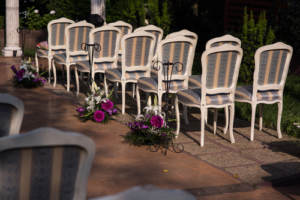Seating Advice for Your Wedding Ceremony

You’re likely to find a lot of advice about planning seating arrangements for your wedding reception. It’s important to consider how you’ll designate where your guests should sit at your ceremony. Whether you’re dealing with 50 guests or 250, a basic organizational structure should guide how you seat your attendees. A few guidelines should help you draft a plan that considers the comfort and enjoyment of your attendees.
Basic Seating Advice
If your family will be attending your nuptials, you’ll probably want to give them first preference when it comes to where they’ll sit. Fortunately, the Emily Post Institute lays out some essential practices for seating immediate family members:
- Parents of the couple in the first row
- Immediate family in the next several rows
- Other guests in the rows behind the couple’s family
The Institute’s guide suggests each partner’s family be assigned a “side” if the pews or rows of seats are divided into two sections inside the venue. For seating partitioned into three sections, place each person’s family on either the extreme right or left sections, while the middle section is taken up by other guests. Whatever you decide, make sure your ushers have a copy of your seating plan, so they can guide attendees to the right areas.
Special Tips for Divorced and Widowed Parents
Many etiquette guidelines were created in an era when it wasn’t common to have a divorced or widowed parent at one’s wedding. Emily Post’s experts offer a few bits of wisdom when it comes to seating. You should permit widowed parents to bring a “plus one” and treat them as an honored guest. Divorced parents still on amicable terms can share the front row. If they don’t get along, you should take care to devise a good alternative. The Institute suggests one possibility: assigning one parent to the front row along with a new spouse if remarried, and then placing that parent’s family in the next few rows before assigning the next open row to the other parent.
Best Practices for Elderly and Disabled Attendees
Meanwhile, Brides writer Terri Pous offers some vital wisdom for making your wedding accessible to elderly and disabled attendees. Pous proposes placing older guests in the first few rows, while people using mobility aids such as wheelchairs, canes, or crutches should be seated on the ends of each row. Moreover, you’ll want to put people with hearing or vision issues near the front. This way they can see and hear as much of the ceremony as possible.
Considerations for Alternative Seating Styles
Most guides for seating wedding guests assume you’re holding your ceremony in a venue with pews or rows of chairs. Nevertheless, you’ll likely need to retool their best practices if you’re using an alternative type of arrangement. Square, circular, and “ceremony in the round” versions can follow similar guidelines for standard layouts, but with a few modifications. For one, you’ll need to assign the closest seats to your parents, with other family members immediately behind them. Also, be sure to place senior and disabled guests near the action, in areas where they can exit the ceremony space without difficulty. Finally, don’t use seating layouts that could cause attendees to struggle with entry, exiting, and general accessibility.
A well-planned seating arrangement lets you and your guests enter and sit down as quickly as possible, but it should also observe good etiquette. In addition to giving family primary placement, it must allow elderly and disabled invitees easy access and exits. Finally, a good seating plan avoids provoking tense moments if either partner has divorced or estranged family. With this seating advice, you’ll accommodate your guests and help make your special day memorable.














